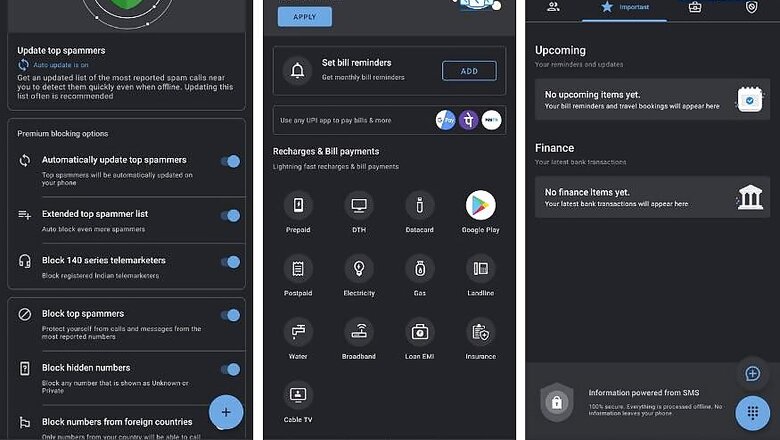
views
How irritating is it that you are in the middle of a busy workday, some busybody is intent on sharing creative ideas that you don’t really need, and deadlines are looming large. It is all going pear shaped, perhaps. In the midst of all this, your Apple iPhone rings. It’s an unknown number. You probably think it’s the restaurant calling to confirm the reservation for your special date with the very special someone later in the evening. Or it is some important work call. Or maybe an update on the courier package you were waiting for—after all it has to arrive today, before the date. But no, it is an unwanted, unsolicited and unwarranted call by a very persistent tele caller convincing you need a new car and a loan to go with that. Doesn’t this happen with you quite often? Does it get on your nerves? It happens with me much more than I would strictly prefer, and it really does get on the nerves.
You and I are not alone in this. Truecaller, the most popular app in the world for managing spam calls and messages, says that in 2019, there were 26 billion spam calls detected. That is pure spam, not unknown calls identified. India logged 25.6 spam calls per user per month on an average, up from 22.3 calls on an average per user per month a year ago. That makes mobile phone users in India the fifth most troubled when it comes to spam, behind Brazil, Peru, Indonesia and Mexico. “Another devastating fact we found during this year is that 1 out of 3 women in India receive sexual harassment or inappropriate calls and SMS on a regular basis,” says the Truecaller data specifically about India.
Community platform LocalCircles also has worrying data to share. The Do Not Disturb (DND) registry is absolutely not working in India. More than 70% of smartphone users still get unwanted SMS even though they are on the DND list. A lot of those come from the mobile service providers themselves. Oh, the irony.
The thing is, when it comes to someone having your back in terms of dealing with spam, there really is no better app to have on your phone than Truecaller. Unfortunately, the experience and spam protection capabilities still are significantly different between Android phones and the Apple iPhone.
Just recently, Truecaller gave the Android app its biggest update in a while—complete with a redesign and much more powerful spam blocking tools for calls and messages. Oh, and the full-screen Caller ID as well, which can save you from engaging with absolutely unnecessary spam calls the moment your phone rings. “Truecaller has been invested in spam blocking for over 10 years now. Our primary purpose is to make communication more efficient for everyone. We have the highest accuracy because our spam and scam markings are community driven. For instance, in India alone, we have over 150 Million active users who help us by identifying spam, scams and fraud calls,” says Rishit Jhunjhunwala, Vice President of Product at Truecaller.
Have you also read?
Truecaller Gets a New Coat of Paint For Android, But in Reality it is Much More Than That
As an iPhone user, it is but obvious to feel left out.
Let me start off by saying that I absolutely love the Apple iPhone experience. Everyone who knows me even remotely knows I’ll not give up an iPhone for an Android phone, as my primary communication device. For me, no other phone comes close to the iPhone for everything that I need. Be it iMessages, FaceTime, Photos, Notes, Apple Music or iCloud, everything just comes together brilliantly, on the hardware and software side of things. The attention to detail to the smallest of things, be it the UI or the UX, make all the difference between an ecosystem that includes an iPhone, a Mac computing device, an iPad, AirPods and an Apple Watch, as against a loosely cobbled together ecosystem that would try to bring together an Android phone, a Windows 10 computing device, some smartwatch and some tablet.
Have you also read?
How I Got My Work Machine Just Right: Apple MacBook Pro, Microsoft 365, Google Drive & More
Yet, even though things have changed significantly over the years, the walled garden problem still remains. And that is perhaps most highlighted every time the phone rings. Truecaller for the iPhone, no matter how robust its foundations may be, simply cannot provide me the same level of spam call or even spam SMS protection that Android users get. The simple reason—Truecaller isn’t allowed access to the CallKit in the way it needs to work effectively. Simply put, CallKit is what dictates the display for incoming or outgoing calls on the calling screen on your iPhone, the call dialing, third party calling services including WhatsApp, as well as any Voice over Internet Protocol (VoIP) service. A few years ago, Truecaller just got enough access with iOS 10 and beyond to show a pop-up detailing who was calling. But that has, at best, been spotty and doesn’t always work well—sometimes the notifications pop up, and mostly they don’t. The thing is, such a method was always going to be a compromise.
Spam management shouldn’t be a compromise, to be very honest.
In my humble opinion, iOS 14 could just be the perfect time for Apple to do a course correction in the battle against a global scourge—spam calls. It has done so before. Apple allowed CallKit to handle VoIP apps such as WhatsApp, Facebook Messenger, Skype and more to integrate into the Phone app on the iPhone. So much so that WhatsApp call screens and interface also looks the same as a regular voice call landing on an iPhone. In fact, I’ve noticed WhatsApp calls also show in the call history in the Phone app.
It is most certain that Apple continues to focus on user data privacy and doesn’t want any app to compromise the security of iOS. However, Truecaller’s case has merit. It is perhaps worth the time and effort to figure out a solution for millions of iPhone users around the world, who struggle with spam calls on a daily basis. I really hope the day when Truecaller works on my iPhone like it works on an Android phone, comes sooner rather than later.
















Comments
0 comment